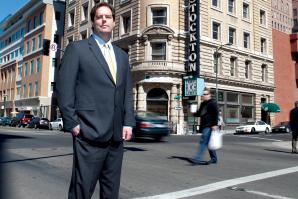After a jarring sell-off and resulting glut, there’s just one word for today’s municipal bond market: precarious.
That means counties and other local agencies are riding out a market of high interest rates and uncertainty. Years of fiscal woes, including a whopping $26 billion state budget deficit, have led to the loss of the state’s credibility among retail investors and a downgrade of its credit rating. Now, with a new governor and administrator in town, along with newly minted legislation designed to streamline the budget process, a period of relative calm has moved into the market, and everyone’s waiting to see if the stability will stick.
“There was a period of instability beginning in November,” says Chris Marx, Sacramento County’s debt officer. “The major underlying cause was investors pulling their money out of municipal bond funds. Everyone was getting jittery, and fund managers had to sell the bonds. There was a glut of managers selling all at once, and there was a cascading effect in the market.”
In February, municipal bond yields, which move contrary to prices, came down slightly. World events, such as civil uprisings and natural disasters, also strengthened demand for bonds, traditionally characterized as low risk.
The notorious sell-off late last year, one of the biggest in decades, spooked investors and resulted in tens of billions of dollars in redemptions for municipal bond funds.
Some market observers point to Veterans Day 2010 as a turning point in the market. The market was closed for the holiday, but ratings firm Standard & Poor’s Register of Corps. downgraded some municipal bonds linked to legal settlements from tobacco companies. When the market reopened the next day, Nov. 12, investors dumped their “junk” tobacco bonds, which led to selling across the board and a three-month slide in municipal bond prices.
Many analysts say the Republican takeover of the House of Representatives also influenced the sell-off, marking a reduction of federal support to financially strapped state and local agencies.
Jeffrey Small, managing partner of Capitol Public Finance Group LLC in Sacramento, characterized the post-Nov. 11 market as being on a “sugar high.” The highly popular Build America Bond, created under the American Recovery and Reinvestment Act and signed into law by President Obama in 2009, was set to expire Dec. 31, 2010.
The taxable municipal bonds carried special tax credits and federal subsidies for either the bond issuer or the bondholder and were designed to prop efforts in economic revitalization, energy conservation and school construction, to name a few, Small says.
“These were subsidized bonds with the U.S. Treasury paying up to 35 percent of the interest costs,” he says. “Government agencies were rushing to sell those bonds before the deadline, so all of a sudden, there was a big supply causing interest rates to move higher.”
This had the effect of discouraging borrowing at the end of 2010 and the beginning of 2011, Small says.
“It’s like having low blood sugar or a blood sugar crash,” he says. “It’s like the Treasury [Department] took away the sugar bowl at the party. There wasn’t a lot of incentive to borrow, and refunding started to dry up because interest rates were moving higher.”
Between Veterans Day 2010 and Jan. 14, yields on a benchmark 30-year general obligation bond went up 22 percent. As credit concerns continued, the market continued to fall throughout January. Since late January, however, yields fell 7 percent, a sign of stabilization.
Anxiety in the municipal bond market was also touched off by predictions from heavy hitters that government agencies could potentially default on bonds. Nationally renowned bank analyst Meredith Whitney predicted up to 100 defaults in the muni bond market, costing investors hundreds of billions of dollars.
While those claims were disputed by some, it was enough to scare off investors, especially in the retail category.
“Her predictions were refuted by many, but it depressed the market,” says Mark Plovnick, director of economic development at University of the Pacific in Stockton. “Any major city or county filing bankruptcy would cause concern again.”
Plovnick says Vallejo went bankrupt but is still paying on bonds.
“Everyone’s under financial stress though, so there’s a feeling that anything is possible,” he says.
The state government deficit and cuts to local governments mean agencies aren’t in a position to launch expensive projects, Small says. In February, however, Small saw an uptick in bond offerings, especially as redevelopment agencies scramble to issue bonds. Gov. Jerry Brown has proposed dissolving redevelopment agencies as a way of closing the budget gap, spurring a flurry of bond offerings.
“In this week alone, we’ve seen 18 bond sales from California redevelopment agencies,” Small said at the end of February. Cities are more active in these sales with only one county in the state participating.
Marx says counties issue municipal bonds for construction, for cash flow or to satisfy accrued liability from pension funds. The county is able to spread the payback of these projects or debts over time with the users paying it back over 20 to 30 years. For instance, the county issues Mello-Roos bonds to build infrastructure in newly developed areas.
The county has recently used bond sales to finance the expansion of the Sacramento International Airport. In the past, it’s also issued bonds for upgrades of the water and solid waste systems and landfills, all of which need a sum of money up front.
For the past several years, during severe financial strain and budget cuts, the county has not had to issue short-term bonds for cash flow. The last bond sale was August 2010 for $128 million for the airport expansion project. The county issued the bonds in advance of rumbling in the market, Marx says, to avoid high interest rates.
“We go to the market with our bonds, to retail and institutional investors, and borrow money from investors who buy our bonds,” she says. “Then we pay back, with interest over a period of years, from the revenues of the airport.”
Stephen Fleming, president and chief executive officer of River City Bank, says a high percentage of municipal bonds are bought by retail investors instead of institutional investors. While banks keep an average of roughly 1.5 percent of their money in bonds, he’s been concerned about credit risks in muni bonds, reducing the bank’s bond allocation from $54 million at the end of 2008 to $32 million at the end of 2010.
He says he’s seeing fundamental changes in the bonds market. The larger investors are getting more selective in bond purchases.
“There are thousands and thousands of issuers, in all shapes and sizes, and people are getting more savvy in their understanding of the risks of different bonds,” Fleming says. “Historically, issuers were all lumped in with U.S. Treasury bonds, but there are differences between general obligation bonds and enterprise bonds, for instance. Some are backed by utilities or pledged revenues from taxpayers.”
Fleming is also seeing uncertainty stemming from fiscal challenges facing state and local governments.
“There’s a much greater level of, or perception of, risk than before,” he says. “There’s a tremendous amount of politics involved in each situation, making it hard to predict. We’re all wondering if there’s a tipping point for issuers, when they are going to stop paying debt on bonds. We’re concerned there will be instances of default.”
Constantine Baranoff, an attorney at Kronick, Moskovitz, Tiedemann & Girard, says the Build America Bonds attracted interest to bonds last year.
“It was unique to allow the public to borrow on the taxable market,” he says. “It attracted a whole new range of investors, creating more demand and pushing down interest rates.”
After a spike in interest rates late last year, the past couple months have seen interest rates for municipal bonds edge down.
“At the end of last year, there was some discomfort in the investor community,” says Baranoff, who represents private and public agencies, and water, school and special districts, along with cities and counties on public financing. “People started to pull out of muni bonds, and because of the adverse relationship between prices and interest rates, the prices went down and the interest rates went up.”
But civil uprisings across the Atlantic and other contemporary events have created uncertainty, meaning investors are flocking back to bonds.
“When there’s general unrest, there’s a flight to quality,” Baranoff says. “So interest rates have gone down a bit because of the Mideast unrest.”
Also, the market is seeing a reduction in the number of bonds issued.
“The volume of bonds is low because not that many are being issued,” Baranoff says. “It’s at the lowest level in a decade. Public agencies have budget problems, which make it hard for them to borrow money, and the political climate is difficult for agencies to borrow money. Everyone’s looking differently at borrowing. It’s a different environment.”
Counties aren’t issuing many bonds as pensions put a strain on budgets and agencies’ ability to borrow money, Baranoff says. School districts are more active because of the sheer number of districts. While land-secured and Mello-Roos financing packages have dropped off, general obligation bonds are the most popular right now and the “safest public financing instrument available,” he says.
Sacramento County is following that trend. Marx says the county hasn’t issued bonds since August and doesn’t have any plans to get into the market.
Baranoff calls the state budget the “800-pound gorilla” as everyone awaits the outcome of proposed budget remedies to shortfalls.
Small says Prop. 25, passed by voters in November 2010, was designed to streamline the state budget.
“It’s good that the state is more likely to get a budget on time because that helps the state in borrowing and funding cash flow,” he says. “Without a credible budget, it’s hard to go out and ask for bonds.”
Small says California lost credibility in the marketplace, which led to the state’s downgrade in credit ratings and an increase in the cost of borrowing for the state.
“The gimmicks were over three years ago, but the state was able to limp along,” he says. “Now the cuts have to happen.”
Small sees much of the problem with polarized political standpoints.
“You have to put those aside,” he says. “You can’t kill the golden goose. If you have a bunch of layoffs, that hurts the economy too. These budget standoffs have cost Californians millions of dollars.”
Small sees hope of stability in muni bond markets.
“California is still a relatively wealthy state, and aside from redevelopment bonds, there’s very little issuance of bond debt, so it’s a good time to borrow,” he says. “We still have dilapidated schools, water systems and levees that need to be fixed.”
Recommended For You

The Stockton Forecast
Acuity with Jeff Michael
Jeff Michael, 42, is the director of the Business Forecasting Center at the University of the Pacific.



